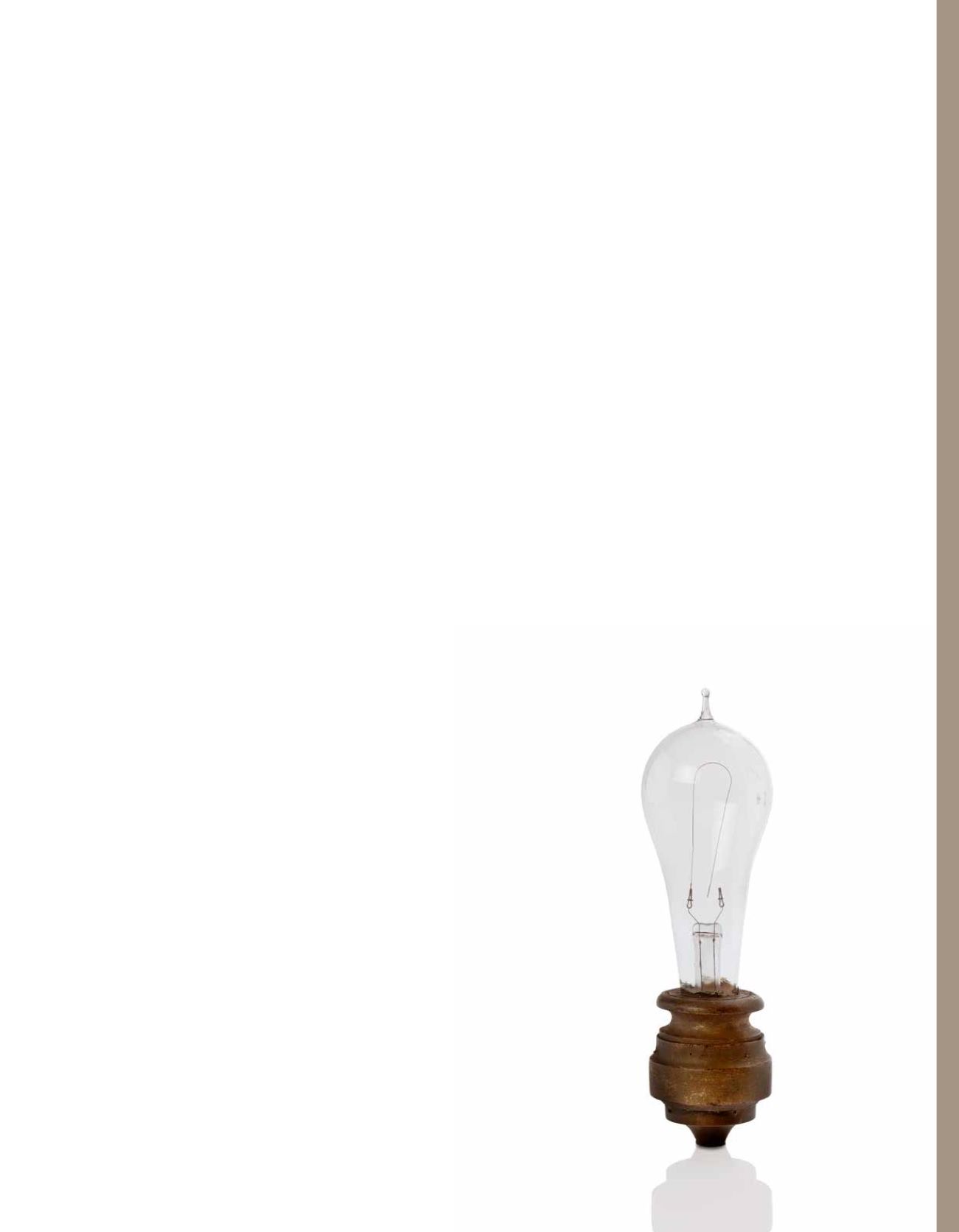

89
britannica - americana
Extraordinaire ensemble de dessins légendés montrant l’effort
d’Edison en mars 1886 pour améliorer l’utilisation de l’ampoule
électrique, conservés avec une ampoule à incandescence originale
à filament en bambou.
[La compétition mondiale pour développer l’arc électrique léger et les
dynamos était intense à la fin des années 1870. L’Europe était bien en
avance sur l’Amérique. En septembre 1878, peu après son invention
du phonographe, Edison annonça qu’il allait inventer un éclairage
électrique peu coûteux qui pourrait remplacer l’éclairage au gaz.
Il travailla quatorze mois à chercher une solution à incandescence
pratique, expérimentant environ 6 000 spécimens de végétaux, et
annonça en décembre 1879 l’invention de l’ampoule à incandescence.
En 1880 il fit des expériences avec une ampoule électrique qui serait
rentable, envoyant son assistant en Chine et au Japon pour trouver
des spécimens de bambou. Un filament en bambou japonais fut
développé plus tard dans l’année.]
L’ampoule
(hauteur 21 cm) a été réalisée à la fin 1880 ou début 1881.
Elle comprend un filament en bambou et une base en bois ainsi qu’une
ampoule en forme de poire. Il s’agit d’un très bel exemple de l’une
des premières ampoules commercialement rentables.
Au cours des années 1880, Edison a continué à travailler sur
l’amélioration des ampoules et sur la façon de les produire plus
efficacement. Les
dessins et notes
de cette collection datent tous
de mars 1886 et portent sur ces expériences.
11 mars 1886
. Dessin signé et légendé. Croquis d’une ampoule
électrique et la pompe à vide (« vac pump ») pour illustrer l’attrait
mutuel entre courants dans des fils de carbone droits.
[1886]
. Croquis représentant une ampoule insérée dans une lampe
avec un commutateur qui dépasse. Quatre formes géométriques sont
tracées sur la droite de l’ampoule.
11 mars 1886
, sur une petite feuille recto-verso. Croquis de quatre
ampoules – deux au recto et deux au verso.
11 mars 1886.
Dessin signé et annoté. Croquis d’une machine électrique
avec isolant pour des isolants / différents métaux.
[1886]
. Dessin annoté. Croquis d’Edison représentant trois ébauches de
tubes et de filaments : lumière Gram / passages circulaires / lubrifiants
passés par en dessous. / Tubes remplis de diverses solutions.
12 mars 1886
. Dessin signé et légendé, représentant trois images
complexes et distinctes : deux d’ampoules à incandescence de 50
et 150 volts, et une qui semble représenter un générateur contrôlé
par la vapeur, avec cette légende : Presser des filaments de réglisse
avec des extrémités élargies.
EDISON THOMAS
(1947-1931).
Six DRAWINGS with autograph NOTES (3 signed « TAE »),
March 1886 ; 6 leaves in-8 format, and 1 leaf in-12, pencil
on ruled paper, placed under see through MILAR in a fitted
green morocco case; also in the fitted case a specimen of
an see-through original light-bulb by Edison.
50 000 / 60 000 €
Extraordinary collection of drawings witnessing Edison’s goal to
improve the use and efficiency of the electric light-bulb in March 1886.
The drawings and autograph notes are here fittingly associated with
an original incandescent light-bulb with its original bamboo filament.
World competition to develop the electric arc and dynamo was,
to say the least, intense towards the end of the 1870s. Europe was
clearly in advance over America. In September 1878, little after the
invention of the phonograph, Edison announced that he wanted to
invent a low-cost system of electrical lighting that could substitute gas-
induced lighting. He worked fourteen months on this project in order
to develop a satisfactory incandescence using material found in nature,
and experimented with approximately 6000 specimens of plants.
He announced in December 1879 the invention of the incandescent
light-bulb. In 1880, Edison experimented with an electrical light-bulb
that could be affordable, sending his assistant to China and Japan to
find the best specimens of bamboo. A filament made of Japanese
bamboo was perfected a bit later in the year 1880.
Sold with
a
light-bulb
made towards the end of 1880 or beginning
of 1881 (height 21 cm). It boasts a bamboo filament and a base made
of wood with a light-bulb shaped like a pear. It is a fine example of
one of the first commercially affordable light-bulbs.
During the 1880s, Edison pursued his research on light-bulbs and
sought to find ways of bettering the invention. The
drawings and notes
in this collection are all dated March 1886 and relate to his endeavour.
11 March 1886
. Drawing, signed and annotated. Sketch of an electrical
light-bulb and its « vac pump » to document electric current and their
mutual attraction in straight carbon wires.
[1886]
. Sketch of a light-bulb placed on a lamp with a switch. Four
geometrical forms are drawn on the right of the light-bulb.
11 March 1886
, on a small recto-verso paper leaf. Sketch of four
light-bulbs, two on the recto and two on the verso.
11 March 1886.
Drawing, signed and annotated. Sketch of an electric
machine with insulating materials.
[1886]
. Drawing, annotated. Sketch by Edison detailing three drafts
or models of tubes and filaments.
12 March 1886.
Drawing, signed and annotated, with three distinct
images: two incandescent light-bulbs, respectively 50 and 150 volts; a
third image showing what appears to be a generator activated by steam.
















